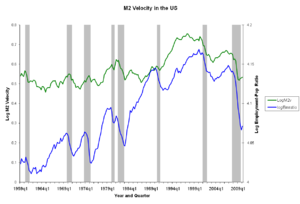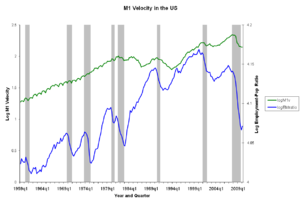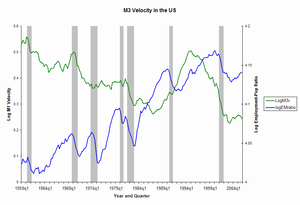- Velocity of money
-
 Chart showing the log of US M2[1][2] money velocity (green), calculated by dividing nominal GDP by M2 stock, M1 plus time deposits. M2 velocity is not stable and correlates with the Employment-Population ratio (blue), an indicator of economic vitality. Both M2 velocity and the Employment-Population Ratio decline in periods of recession (represented with gray bars). The pattern conflicts with the quantity theory of money, which assumes that money velocity will be stable and only loosely correlated with economic conditions.[3]
Chart showing the log of US M2[1][2] money velocity (green), calculated by dividing nominal GDP by M2 stock, M1 plus time deposits. M2 velocity is not stable and correlates with the Employment-Population ratio (blue), an indicator of economic vitality. Both M2 velocity and the Employment-Population Ratio decline in periods of recession (represented with gray bars). The pattern conflicts with the quantity theory of money, which assumes that money velocity will be stable and only loosely correlated with economic conditions.[3]
The velocity of money (also called velocity of circulation) is the average frequency with which a unit of money is spent in a specific period of time. Velocity associates the amount of economic activity associated with a given money supply. When the period is understood, the velocity may be presented as a pure number; otherwise it should be given as a pure number over time. In the equation of exchange, velocity of money is one of the variables claimed to determine inflation.
Contents
Illustration
If, for example, in a very small economy, a farmer and a mechanic, with just $50 between them, buy goods and services from each other in just three transactions over the course of a year
- Farmer spends $50 on tractor repair from mechanic.
- Mechanic buys $40 of corn from farmer.
- Mechanic spends $10 on barn cats from farmer.
then $100 changed hands in course of a year, even though there is only $50 in this little economy. That $100 level is possible because each dollar was spent an average of twice a year, which is to say that the velocity was 2 / yr.
Indirect measurement
In practice, attempts to measure the velocity of money are usually indirect:
where
 is the velocity of money for all transactions.
is the velocity of money for all transactions. is the nominal value of aggregate transactions.
is the nominal value of aggregate transactions. is the total amount of money in circulation on average in the economy (see “Money supply” for details).
is the total amount of money in circulation on average in the economy (see “Money supply” for details).
(Given the classical dichotomy, nT may be factored into a product
 of a price level P and a 'real' aggregate value of transactions T.)
of a price level P and a 'real' aggregate value of transactions T.)Values of nT and M permit calculation of VT.
As applied to an economy, expenditures on final output are of interest; the relation may be written:
where
 is the velocity for transactions counting towards national or domestic product.
is the velocity for transactions counting towards national or domestic product. is nominal national or domestic product.
is nominal national or domestic product.
(Analogously with nT, given the classical dichotomy, nQ may be factored into a product
 .)
.)Determination
The determinants and consequent stability of the velocity of money are a subject of controversy across and within schools of economic thought. Those favoring a quantity theory of money have tended to believe that, in the absence of inflationary or deflationary expectations, velocity will be technologically determined and stable, and that such expectations will not generally arise without a signal that overall prices have changed or will change.
The view that velocity of money is constant is criticized by Samuelson thus:
In terms of the quantity theory of money, we may say that the velocity of circulation of money does not remain constant. “You can lead a horse to water, but you can’t make him drink.” You can force money on the system in exchange for government bonds, its close money substitute; but you can’t make the money circulate against new goods and new jobs.[4]
References
Notes
- ^ M2 Definition - Investopedia
- ^ M2 Money Stock - Federal Reserve Bank of St Louis
- ^ Mishkin, Frederic S. The Economics of Money, Banking, and Financial Markets. Seventh Edition. Addison-Wesley. 2004. p.520.
- ^ Samuelson, Paul Anthony; Economics (1948), p 354.
Sources
- Cramer, J.S. “velocity of circulation”, The New Palgrave: A Dictionary of Economics(1987), v. 4, pp. 601-02.
- Friedman, Milton; “quantity theory of money”, in The New Palgrave: A Dictionary of Economics (1987), v. 4, pp. 3-20.
External links
- Velocity of money data - from the St. Louis Fed's FRED database
Categories:- Monetary economics
- Economics terminology
Wikimedia Foundation. 2010.




